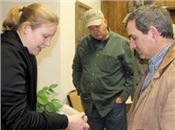Strip Trial Data Shows Effect Of Soybean Seed Treatment

MU Extension plant pathologist Kaitlyn Bissonnette shows roots
of soybean plants infected with soybean cyst nematode.
COLUMBIA, MO.
Soybean seed treatment provided a bump in yield but did not show much effect on soybean cyst nematode (SCN) egg counts in 2017 and 2018 data from the University of Missouri Strip Trial Program.
As part of the trial, MU researchers studied the impact of ILeVO seed treatment on SCN egg counts and yield. They conducted trials in 19 locations in 2017 and 10 locations in 2018.
MU Extension plant pathologist Kaitlyn Bissonnette says initial data shows that ILeVO did not consistently reduce SCN egg counts and in some cases slightly increased egg counts.
“In the strip trials, we observed quite a bit of variability in SCN egg counts even within a field and between treatments,” Bissonnette says.
The data is consistent with small-plot research at Iowa State University and results reported by the Iowa Soybean Association OnFarm Network.
Researchers took soil samples the first week of planting and the week of harvest to measure the number of SCN eggs in the soil.
In another crop-protection strip trial, Bissonnette looked at whether a fungicide applied to soybeans at the R3 growth stage effectively reduced foliar disease.
The dry 2018 growing season contributed to the low levels of foliar disease. Septoria brown spot was observed at all 10 locations and frogeye leaf spot was observed at eight locations, but levels of both diseases were low. At one location where a susceptible variety of soybean was planted, frogeye leaf spot severity was greater in the untreated strips than the fungicide-treated strips. At all locations, researchers found no yield difference between treated and untreated strips.
Learn more about the program at striptrial.missouri.edu.
About the MU Strip Trial Program
Farmers use their own equipment to conduct on-farm research in their own fields.
Participating farmers work with a specialist from the University of Missouri Extension, or other crop consultant of their choice, to guide the planning, implementation and methodology used for the trial.
This extra guidance helps ensure growers receive a reliable, statistically valid and unbiased evaluation of a particular practice, method or idea. ∆

Soybean cyst nematode, shown under a microscope at a recent SCN workshop, robs soybean fields
of up to 14 bushels per acre. SCN is present in more than 75 percent of Missouri soybean fields.